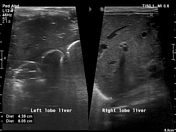Umbilical venous catheter-related hepatic fluid collection (TPNoma) and abscess formation
Presentation
Premature birth. Raised inflammatory markers and signs of sepsis on day 5.
Patient Data

The lung fields are hyperinflated. The ET tube is at the C7 vertebral body level and needs to be distally inserted. There is right upper lobe collapse with veiling, likely due to mucous plugging with volume loss as evidenced by the right-sided tracheomediastinal deviation. There is a surfactant deficiency disorder. There are overlying ECG leads and an overlying temperature lead. The nasogastric tube is satisfactorily sited. The umbilical arterial catheter (UAC) is satisfactorily sited at the T7 vertebral body level (high position).
A malpositioned umbilical venous catheter (UVC) is likely within the right portal vein or branch, with adjacent gaseous locules.
A limited view of the upper abdomen appears otherwise normal.

The follow-up X-ray confirms a residual malpositioned UVC with a suspicious, circumscribed adjacent gaseous locule.
The ETT has been adjusted and is now infraclavicular at the T1 vertebral level.
The right upper lobe veiling and collapse have resolved. The ground-glass opacities remain consistent with prematurity and surfactant deficiency disorders.
The UAC and nasogastric tubes remain satisfactorily sited, with overlying ECG leads and an overlying temperature lead.



The portable ultrasound confirms a heterogenous intrahepatic collection with a hyperechoic rim and hypoechoic center containing cystic areas with gas within segment 8, measuring 23.9 x 18.0 x 27.3 mm in diameter. The malpositioned UVC is well-identified, leading to the mixed echogenic intrahepatic collection. The UAC is identified within the aorta.
The cine loop further demonstrates the malpositioned UVC and correctly sited UAC.
Case Discussion
One of the complications of a malpositioned umbilical venous catheter is the formation of a complicated intrahepatic fluid collection 1. This is due to the infusion of hypertonic fluid, including TPN1. Hence, the collection can be called a TPNoma when it's due to a TPN infusion. In this instance, there is a confirmed infusion of both TPN and hypertonic fluid.
Acute collections appear as homogeneous, hyperechoic, or echogenic mass-like lesions, while subacute collections appear heterogeneous with an echogenic rim and hypoechoic center containing cystic areas due to tissue necrosis 1.
The collection was confirmed on the day 7 ultrasound and appeared subacute based on the above description, with a well-identified, irregular, and mixed appearance sonographically.
The collection was likely infected too, with the appreciation and identification of gaseous locules on the day 5 portable X-ray and a solitary circumscribed lucency on the day 7 X-ray.
The neonate was treated with intravenous antibiotics during the intensive care stay with the removal of the malpositioned umbilical venous line. The infected TPNoma/hepatic abscess was resolved through conservative management without the need for interventional percutaneous aspiration.




 Unable to process the form. Check for errors and try again.
Unable to process the form. Check for errors and try again.